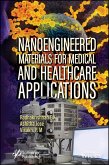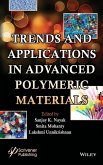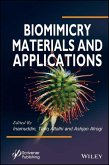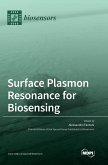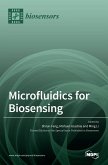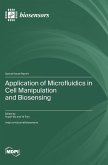Gupta
Soft Materials-Based Biosensing Medical Applications
Herausgeber: Gupta, Deepak; Sundram, Sonali; Malviya, Rishabha; Singh, Milan
Gupta
Soft Materials-Based Biosensing Medical Applications
Herausgeber: Gupta, Deepak; Sundram, Sonali; Malviya, Rishabha; Singh, Milan
- Gebundenes Buch
- Merkliste
- Auf die Merkliste
- Bewerten Bewerten
- Teilen
- Produkt teilen
- Produkterinnerung
- Produkterinnerung
The book offers a comprehensive, interdisciplinary overview of how innovative soft materials are revolutionizing biosensing technologies, making it an essential read for anyone interested in cutting-edge advancements in biomedical research and healthcare. Soft materials include granular materials, foams, gels, polymers, surfactants, functional organics, and biological molecules. These structures can be altered by thermal or mechanical stress due to their ability to self-organize into mesoscopic physical structures. They are becoming increasingly significant as functional materials for broader…mehr
Andere Kunden interessierten sich auch für
![Two-Dimensional Nanomaterials for Biosensing and Imaging Applications Two-Dimensional Nanomaterials for Biosensing and Imaging Applications]() SinghTwo-Dimensional Nanomaterials for Biosensing and Imaging Applications215,99 €
SinghTwo-Dimensional Nanomaterials for Biosensing and Imaging Applications215,99 €![Nanoengineered Materials for Medical and Healthcare Applications Nanoengineered Materials for Medical and Healthcare Applications]() E.K.Nanoengineered Materials for Medical and Healthcare Applications172,99 €
E.K.Nanoengineered Materials for Medical and Healthcare Applications172,99 €![Trends and Applications in Advanced Polymeric Materials Trends and Applications in Advanced Polymeric Materials]() Trends and Applications in Advanced Polymeric Materials193,99 €
Trends and Applications in Advanced Polymeric Materials193,99 €![Biomimicry Materials and Applications Biomimicry Materials and Applications]() InamuddinBiomimicry Materials and Applications172,99 €
InamuddinBiomimicry Materials and Applications172,99 €![Surface Plasmon Resonance for Biosensing Surface Plasmon Resonance for Biosensing]() Surface Plasmon Resonance for Biosensing77,99 €
Surface Plasmon Resonance for Biosensing77,99 €![Microfluidics for Biosensing Microfluidics for Biosensing]() Microfluidics for Biosensing72,99 €
Microfluidics for Biosensing72,99 €![Application of Microfluidics in Cell Manipulation and Biosensing Application of Microfluidics in Cell Manipulation and Biosensing]() Application of Microfluidics in Cell Manipulation and Biosensing73,99 €
Application of Microfluidics in Cell Manipulation and Biosensing73,99 €-
-
-
The book offers a comprehensive, interdisciplinary overview of how innovative soft materials are revolutionizing biosensing technologies, making it an essential read for anyone interested in cutting-edge advancements in biomedical research and healthcare. Soft materials include granular materials, foams, gels, polymers, surfactants, functional organics, and biological molecules. These structures can be altered by thermal or mechanical stress due to their ability to self-organize into mesoscopic physical structures. They are becoming increasingly significant as functional materials for broader applications because of their rich surface chemistry and versatile functions. A biosensor is an analytical tool for chemical compound detection that combines a biological element with a physicochemical detector. Sensitive biological components, such as proteins, carbohydrates, tissue, bacteria, and enzymes, are collected from a biomimetic element that interacts and binds with the analyte under investigation. In biosensors, soft matter may function as both a sensing and transducing component. The interplay of soft matter with biomolecular analytes results in cell signaling pathways, diagnostic tests for applications in low-resource environments, prospective drug development, molecular biodetection, chemical sensors, and biological sensors. Understanding these biomolecular interactions in the context of acute illnesses is critical for biomedical research and healthcare. This has fueled efforts to create a biosensor that is effective, low-cost, and label-free. Several approaches using soft materials to functionalize and tailor structures have greatly advanced science, including chemistry, physics, pharmaceutical science, materials science, and engineering. Soft Materials-Based Biosensing Medical Applications summarizes recent advances in soft materials with unique physicochemical properties that synergistically promote biosensing systems. Audience The book will be read by researchers, materials scientists, electronic and AI engineers, as well as pharmaceutical and biomedical professionals interested in the uses of biosensing.
Produktdetails
- Produktdetails
- Verlag: Wiley
- Seitenzahl: 528
- Erscheinungstermin: 13. Mai 2025
- Englisch
- Abmessung: 254mm x 178mm x 31mm
- ISBN-13: 9781394213559
- ISBN-10: 1394213557
- Artikelnr.: 69825362
- Herstellerkennzeichnung
- Libri GmbH
- Europaallee 1
- 36244 Bad Hersfeld
- gpsr@libri.de
- Verlag: Wiley
- Seitenzahl: 528
- Erscheinungstermin: 13. Mai 2025
- Englisch
- Abmessung: 254mm x 178mm x 31mm
- ISBN-13: 9781394213559
- ISBN-10: 1394213557
- Artikelnr.: 69825362
- Herstellerkennzeichnung
- Libri GmbH
- Europaallee 1
- 36244 Bad Hersfeld
- gpsr@libri.de
Deepak Gupta, PhD, is an assistant professor in the School of Basic and Applied Sciences at Galgotias University, India. He has two patents to his credit, has published more than nine research papers, and has attended and organized more than 20 national and international conferences and workshops. His areas of interest include liquid crystals, molecular electronics, soft matter computation, and computational chemistry. Milan Singh, PhD, is an assistant professor in the Department of Physics, School of Basic and Applied Sciences, Galgotias University, with more than six years of research experience. She has published 12 articles in international journals of repute. Her areas of interest include energy storage devices, supercapacitors, Li-ion batteries, nanoscience, nanotechnology, nanofibers, and nanocomposites. Rishabha Malviya, PhD, is an associate professor in the Department of Pharmacy, School of Medical and Allied Sciences, Galgotias University, with over 12 years of research experience. He has authored more than 150 research papers for national and international journals of repute, edited twelve books, and has been granted 15 patents, with 40 more under evaluation. He also serves as an editorial board member for more than 40 journals. His areas of interest include formulation optimization, nanoformulation, targeted drug delivery, artificial intelligence in healthcare, localized drug delivery, and natural polymers as pharmaceutical excipients. Sonali Sundram, PhD, is a researcher in Galgotias University, Greater Noida, India. She has worked as a research scientist at King George's Medical University, Lucknow. Her PhD (Pharmacy) work was in the area of neurodegeneration and nanoformulation and her area of interest is neurodegeneration, clinical research, and artificial intelligence. She has authored/edited more than 30 books and has more than eight patents national and international in her credit.
Foreword xvii
Preface xix
1 Introduction to Soft Materials 1
Athul Satya and Ayon Bhattacharjee
List of Abbreviations 1
1.1 Introduction 1
1.2 Brief Introduction to Theories of Soft Matter 2
1.3 Classification of Soft Materials 3
1.4 Hydrophobic and Hydrophilic Materials 11
1.5 Characteristics of Soft Matter 12
1.6 Summary 22
References 22
2 Synthesizing Soft Materials: Lab to an Industrial Approach 25
Varsha Jain, Tarang Gupta and Madhusudan Maity
List of Abbreviations 26
2.1 Introduction 27
2.2 Soft Condensed Matter 28
2.3 Synthesis of Smart Functional LCs 38
2.4 Conclusions 66
References 67
3 Liquid Crystal as a Potential Biosensing Material 81
Athul Satya, Tayssir Missaoui, Gurumurthy Hegde and Ayon Bhattacharjee
List of Abbreviations 81
3.1 Introduction 82
3.2 Classification of LC Biosensor 84
3.3 LC-Microfluidic Biosensor 90
3.4 Electric Field-Assisted Signal Amplified LC Biosensor 93
3.5 LC-Based Whispering Gallery Mode Microcavity Biosensing 93
3.6 LC Biosensors Using Different Sensing Targets 94
3.7 Summary 98
References 98
4 Cholesteric Liquid Crystal Emulsions for Biosensing 103
Buchaiah Gollapelli and Jayalakshmi Vallamkondu
List of Abbreviations 103
4.1 Introduction 104
4.2 Fabrication of LC Emulsions 114
4.3 CLCs in Biosensor Applications 118
4.4 Challenges and Opportunities 124
4.5 Conclusions 124
References 125
5 Design and Study of Ionic Hydrogel Strain Sensors for Biomedical
Applications 131
Aanchal Saxena
List of Abbreviations 131
5.1 Introduction 131
5.2 Applications in Biomedicine 133
5.3 Hydrogels 135
5.4 Hardware 137
5.5 Characteristics of the Hydrogel 139
5.6 Limitations 139
5.7 Conclusions and Further Study 139
Acknowledgments 139
References 140
6 Colloidal Nanoparticles as Potential Optical Biosensors for Cancer
Biomarkers 145
Karthika Lakshmi Servarayan, Maziah Mohd Ghazaly, Manickam Sundarapandi,
Jagathiswary Ganasan, Kavin Tamilselvan, Syahidatun Nisak Amir, Nur Arisya
Farazuana Dzulkifli, Noor Fatin Shabira Mohd Azli, Rameshkumar Santhanam
and Vasantha Vairathevar Sivasamy
List of Abbreviations 145
6.1 Introduction 146
6.2 Cancer Biomarkers 149
6.3 Colloidal NP-Based Optical Biosensors for Cancer Biomarkers 150
6.4 Opportunities, Challenges, and Future Perspectives 157
6.5 Conclusions 158
Acknowledgment 159
References 159
7 Polymeric Composite Soft Materials for Anticancer Drug Delivery and
Detection 165
Thangarasu Mohanraj, Thavasilingam Nagendraraj, Jamespandi Annaraj and
Vairathevar Sivasamy Vasantha
List of Abbreviations 166
7.1 Introduction 168
7.2 Polymer Composite Soft Material-Based Anticancer Drug Delivery 176
7.3 Polymer Composite Soft Material-Based Sensors for Anticancer Drug
Detection 184
7.4 Discussion 199
7.5 Conclusion 206
Acknowledgment 206
References 206
8 Nanotechnology-Doped Soft Material-Based Biosensors 217
Smriti Ojha, Ankita Moharana, Gowri Shankar Chintapalli, Shivendra Mani
Tripathi and Sudhanshu Mishra
List of Abbreviations 218
8.1 Introduction 218
8.2 The Principle Behind Doped Soft Nanomaterial-Based Biosensor 219
8.3 Classification of Soft Materials 221
8.4 Physical and Chemical Behavior of Soft Material 224
8.5 Synthesis of Soft Nanomaterial-Based Biosensor 225
8.6 Application of Nano-Based Biosensor 227
8.7 Emerging Trends and Future Directions in Nanotechnology-Doped Soft
Material-Based Biosensors 227
8.8 Challenges and Limitations 228
8.9 Conclusion 228
References 229
9 Cancer Cell Biomarker Exosomes are Detected by Biosensors Based on Soft
Materials 233
Subha Ranjan Das
9.1 Introduction 233
9.2 Exosome Biogenesis, Isolation, and Study of Exosome Composition 235
9.3 Exosome Profiling 237
9.4 Exosomes Produced by Cancer: Clinical Evaluation 239
9.5 Important Biosensor-Related Components 242
9.6 Soft Material-Based Biosensors are a Recent Development in Cancer Cell
Biomarker Exosome Detection 245
9.7 Conclusion and Future Perspectives 261
References 263
10 Natural-Product-Based Soft Materials in Electrochemical Biosensors for
Cancer Biomarkers 275
Shunmuga Nainar Shunmuga Nathan, Wan Iryani Wan Ismail, Piraman
Shakkthivel, Vairathevar Sivasamy Vasantha and Mathew Mathew
List of Abbreviations 276
10.1 Introduction 278
10.2 Biopolymer Composite-Based Electrochemical Biosensors for Cancer
Biomarkers 281
10.3 Protein/Amino Acid-Based Electrochemical Biosensors for Cancer
Biomarkers 287
10.4 Opportunities, Future Recommendations, and Challenges 293
10.5 Conclusions 303
10.6 Acknowledgments 303
References 303
11 Recent Advances and Development in 3D Printable Biosensors 311
Lata Sheo Bachan Upadhyay and Pratistha Bhagat
List of Abbreviations 312
11.1 Introduction 313
11.2 3D Printable Biosensors Based on Technology 317
11.3 3D Printable Biosensors Based on Product Type 326
11.4 3D Printable Biosensors Based on Medical Applications 329
11.5 3D Printable Biosensors Based on Sensor Types 332
11.6 Conclusion 334
References 335
12 Computational Panorama of Soft Material for Biosensing Applications 341
Deepak Kajla, Dinesh Kumar Sharma and Amit Mittal
Abbreviations 341
12.1 Introduction 343
12.2 Computational Application of Soft Gel Biosensing Techniques in
Microfluids 349
12.3 Computational Panorama of Soft Hydrogel Technique in Diagnostics 350
12.4 Computational Landscaping of Spectroscopy-Based Biosensors and Their
Applications 354
12.5 Use of Wearable Biosensors in Computation for Treatment, Diagnosis,
and Medical Monitoring 357
12.6 Computational Panorama of Optical Biosensor 359
12.7 Computational Applications of Hydrogel-Based Sensor Networks 360
12.8 Hydrogel-Based Self-Supporting Materials with Computational Panorama
for Flexible/Stretchable Sensors 361
12.9 Waterborne Pathogen Detection Using Biosensors and Molecular
Techniques 362
12.10 Applications of Biomimetic Electrochemical Devices in Detecting 362
12.11 The Latest Developments in Hydrogels for Sensing Applications 363
12.12 Novel Aerial Image of Dissolving Microneedles Used for Transdermal
Medicine Delivery 363
12.13 Making Use of Potentiometric Biosensors to Find Biomarkers 364
12.14 Biosensor Framework Enabled by Multiphoton Effects and Machine
Learning 364
12.15 Conclusion 365
References 366
13 Soft Materials for Implantable Biosensors for Humans 369
Periyasamy Ananthappan, Karuppathevan Ramki, Jayalakshmi Mariakuttikan,
Fatimah binti Hashim and Vairathevar Sivasamy Vasantha
List of Abbreviations 369
13.1 Introduction 372
13.2 Nature of Implantable Materials 373
13.3 Importance of Soft Materials in the Field of Implantable Biosensors
373
13.4 Types of Soft Materials 377
13.5 Factors Influencing the Implantable Biosensors 382
13.6 Applications of Soft Materials for Implantable Biosensors in Humans
386
13.7 Challenges for Soft Materials for Implantable Biosensors 408
13.8 Recommendation 411
13.9 Conclusions 412
Acknowledgments 412
References 412
14 Treatment of Diabetic Patients with Functionalized Biomaterials 423
Jyotsna Priyam
List of Abbreviations 423
14.1 Background and Introduction 424
14.2 Mechanism of Insulin Release in Diabetes Mellitus 425
14.3 Relationship Between Diabetic Complications and Glycation Process 426
14.4 Biomaterials and Their Surface Functionalization 428
14.5 Surface Functionalization of Biomaterials Using Surface Modification
Technologies 429
14.6 Biomaterials with Natural Polymer Bases to Treat Diabetes 430
14.7 Biomaterials Based on Chitosan for the Treatment of Diabetes 432
14.8 Synthetic Polymer-Based Biomaterials for the Treatment of Diabetes 432
14.9 Hydrogel-Based Adaptable Biomaterials for Managing and Treating
Diabetes 434
14.10 Topical Gel-Based Biomaterials for Diabetic Foot Ulcer Therapy 434
14.11 Creating Immunomodulatory Biomaterials to Treat Diabetes 435
14.12 Using Functionalized Biomaterials in Diabetic Wound Management 437
14.13 Applications of Functionalized Biomaterials for Diabetes
Mellitus-Related Tissue Engineering 441
14.14 Conclusion and Future Scope 442
Acknowledgments 442
References 442
15 Treatment and Detection of Oral Cancer Using Biosensors: Advances and
Prospective 449
Shatrudhan Prajapati, Rishabha Malviya and Priyanshi Goyal
List of Abbreviations 449
15.1 Introduction 450
15.2 Therapeutic Value of Mouth Liquids as a Bio Medium 457
15.3 Salivary Metabolomics 459
15.4 Electrochemical Biosensors 459
15.5 Biosensors on a Nanoscale 461
15.6 Conclusions 461
References 462
16 Environmental Aspect of Soft Material: Journey of Sustainable and
Cost-Effective Biosensors from Lab to Industry 467
Harshita Rana, Pratichi Singh, Ashish Kumar Agrahari and Shikha Yadav
List of Abbreviations 468
16.1 Introduction 469
16.2 Soft Materials 469
16.3 Environmental Impact 472
16.4 Biosensors 474
16.5 Applications of Biosensors in Several Disciplines 478
16.6 Advancement in Biosensors 482
16.7 Fluorescent Tag Biosensors 483
16.8 Plasmonic Fiber Optic Biosensors 485
16.9 Conclusion 486
References 487
Index 493
Preface xix
1 Introduction to Soft Materials 1
Athul Satya and Ayon Bhattacharjee
List of Abbreviations 1
1.1 Introduction 1
1.2 Brief Introduction to Theories of Soft Matter 2
1.3 Classification of Soft Materials 3
1.4 Hydrophobic and Hydrophilic Materials 11
1.5 Characteristics of Soft Matter 12
1.6 Summary 22
References 22
2 Synthesizing Soft Materials: Lab to an Industrial Approach 25
Varsha Jain, Tarang Gupta and Madhusudan Maity
List of Abbreviations 26
2.1 Introduction 27
2.2 Soft Condensed Matter 28
2.3 Synthesis of Smart Functional LCs 38
2.4 Conclusions 66
References 67
3 Liquid Crystal as a Potential Biosensing Material 81
Athul Satya, Tayssir Missaoui, Gurumurthy Hegde and Ayon Bhattacharjee
List of Abbreviations 81
3.1 Introduction 82
3.2 Classification of LC Biosensor 84
3.3 LC-Microfluidic Biosensor 90
3.4 Electric Field-Assisted Signal Amplified LC Biosensor 93
3.5 LC-Based Whispering Gallery Mode Microcavity Biosensing 93
3.6 LC Biosensors Using Different Sensing Targets 94
3.7 Summary 98
References 98
4 Cholesteric Liquid Crystal Emulsions for Biosensing 103
Buchaiah Gollapelli and Jayalakshmi Vallamkondu
List of Abbreviations 103
4.1 Introduction 104
4.2 Fabrication of LC Emulsions 114
4.3 CLCs in Biosensor Applications 118
4.4 Challenges and Opportunities 124
4.5 Conclusions 124
References 125
5 Design and Study of Ionic Hydrogel Strain Sensors for Biomedical
Applications 131
Aanchal Saxena
List of Abbreviations 131
5.1 Introduction 131
5.2 Applications in Biomedicine 133
5.3 Hydrogels 135
5.4 Hardware 137
5.5 Characteristics of the Hydrogel 139
5.6 Limitations 139
5.7 Conclusions and Further Study 139
Acknowledgments 139
References 140
6 Colloidal Nanoparticles as Potential Optical Biosensors for Cancer
Biomarkers 145
Karthika Lakshmi Servarayan, Maziah Mohd Ghazaly, Manickam Sundarapandi,
Jagathiswary Ganasan, Kavin Tamilselvan, Syahidatun Nisak Amir, Nur Arisya
Farazuana Dzulkifli, Noor Fatin Shabira Mohd Azli, Rameshkumar Santhanam
and Vasantha Vairathevar Sivasamy
List of Abbreviations 145
6.1 Introduction 146
6.2 Cancer Biomarkers 149
6.3 Colloidal NP-Based Optical Biosensors for Cancer Biomarkers 150
6.4 Opportunities, Challenges, and Future Perspectives 157
6.5 Conclusions 158
Acknowledgment 159
References 159
7 Polymeric Composite Soft Materials for Anticancer Drug Delivery and
Detection 165
Thangarasu Mohanraj, Thavasilingam Nagendraraj, Jamespandi Annaraj and
Vairathevar Sivasamy Vasantha
List of Abbreviations 166
7.1 Introduction 168
7.2 Polymer Composite Soft Material-Based Anticancer Drug Delivery 176
7.3 Polymer Composite Soft Material-Based Sensors for Anticancer Drug
Detection 184
7.4 Discussion 199
7.5 Conclusion 206
Acknowledgment 206
References 206
8 Nanotechnology-Doped Soft Material-Based Biosensors 217
Smriti Ojha, Ankita Moharana, Gowri Shankar Chintapalli, Shivendra Mani
Tripathi and Sudhanshu Mishra
List of Abbreviations 218
8.1 Introduction 218
8.2 The Principle Behind Doped Soft Nanomaterial-Based Biosensor 219
8.3 Classification of Soft Materials 221
8.4 Physical and Chemical Behavior of Soft Material 224
8.5 Synthesis of Soft Nanomaterial-Based Biosensor 225
8.6 Application of Nano-Based Biosensor 227
8.7 Emerging Trends and Future Directions in Nanotechnology-Doped Soft
Material-Based Biosensors 227
8.8 Challenges and Limitations 228
8.9 Conclusion 228
References 229
9 Cancer Cell Biomarker Exosomes are Detected by Biosensors Based on Soft
Materials 233
Subha Ranjan Das
9.1 Introduction 233
9.2 Exosome Biogenesis, Isolation, and Study of Exosome Composition 235
9.3 Exosome Profiling 237
9.4 Exosomes Produced by Cancer: Clinical Evaluation 239
9.5 Important Biosensor-Related Components 242
9.6 Soft Material-Based Biosensors are a Recent Development in Cancer Cell
Biomarker Exosome Detection 245
9.7 Conclusion and Future Perspectives 261
References 263
10 Natural-Product-Based Soft Materials in Electrochemical Biosensors for
Cancer Biomarkers 275
Shunmuga Nainar Shunmuga Nathan, Wan Iryani Wan Ismail, Piraman
Shakkthivel, Vairathevar Sivasamy Vasantha and Mathew Mathew
List of Abbreviations 276
10.1 Introduction 278
10.2 Biopolymer Composite-Based Electrochemical Biosensors for Cancer
Biomarkers 281
10.3 Protein/Amino Acid-Based Electrochemical Biosensors for Cancer
Biomarkers 287
10.4 Opportunities, Future Recommendations, and Challenges 293
10.5 Conclusions 303
10.6 Acknowledgments 303
References 303
11 Recent Advances and Development in 3D Printable Biosensors 311
Lata Sheo Bachan Upadhyay and Pratistha Bhagat
List of Abbreviations 312
11.1 Introduction 313
11.2 3D Printable Biosensors Based on Technology 317
11.3 3D Printable Biosensors Based on Product Type 326
11.4 3D Printable Biosensors Based on Medical Applications 329
11.5 3D Printable Biosensors Based on Sensor Types 332
11.6 Conclusion 334
References 335
12 Computational Panorama of Soft Material for Biosensing Applications 341
Deepak Kajla, Dinesh Kumar Sharma and Amit Mittal
Abbreviations 341
12.1 Introduction 343
12.2 Computational Application of Soft Gel Biosensing Techniques in
Microfluids 349
12.3 Computational Panorama of Soft Hydrogel Technique in Diagnostics 350
12.4 Computational Landscaping of Spectroscopy-Based Biosensors and Their
Applications 354
12.5 Use of Wearable Biosensors in Computation for Treatment, Diagnosis,
and Medical Monitoring 357
12.6 Computational Panorama of Optical Biosensor 359
12.7 Computational Applications of Hydrogel-Based Sensor Networks 360
12.8 Hydrogel-Based Self-Supporting Materials with Computational Panorama
for Flexible/Stretchable Sensors 361
12.9 Waterborne Pathogen Detection Using Biosensors and Molecular
Techniques 362
12.10 Applications of Biomimetic Electrochemical Devices in Detecting 362
12.11 The Latest Developments in Hydrogels for Sensing Applications 363
12.12 Novel Aerial Image of Dissolving Microneedles Used for Transdermal
Medicine Delivery 363
12.13 Making Use of Potentiometric Biosensors to Find Biomarkers 364
12.14 Biosensor Framework Enabled by Multiphoton Effects and Machine
Learning 364
12.15 Conclusion 365
References 366
13 Soft Materials for Implantable Biosensors for Humans 369
Periyasamy Ananthappan, Karuppathevan Ramki, Jayalakshmi Mariakuttikan,
Fatimah binti Hashim and Vairathevar Sivasamy Vasantha
List of Abbreviations 369
13.1 Introduction 372
13.2 Nature of Implantable Materials 373
13.3 Importance of Soft Materials in the Field of Implantable Biosensors
373
13.4 Types of Soft Materials 377
13.5 Factors Influencing the Implantable Biosensors 382
13.6 Applications of Soft Materials for Implantable Biosensors in Humans
386
13.7 Challenges for Soft Materials for Implantable Biosensors 408
13.8 Recommendation 411
13.9 Conclusions 412
Acknowledgments 412
References 412
14 Treatment of Diabetic Patients with Functionalized Biomaterials 423
Jyotsna Priyam
List of Abbreviations 423
14.1 Background and Introduction 424
14.2 Mechanism of Insulin Release in Diabetes Mellitus 425
14.3 Relationship Between Diabetic Complications and Glycation Process 426
14.4 Biomaterials and Their Surface Functionalization 428
14.5 Surface Functionalization of Biomaterials Using Surface Modification
Technologies 429
14.6 Biomaterials with Natural Polymer Bases to Treat Diabetes 430
14.7 Biomaterials Based on Chitosan for the Treatment of Diabetes 432
14.8 Synthetic Polymer-Based Biomaterials for the Treatment of Diabetes 432
14.9 Hydrogel-Based Adaptable Biomaterials for Managing and Treating
Diabetes 434
14.10 Topical Gel-Based Biomaterials for Diabetic Foot Ulcer Therapy 434
14.11 Creating Immunomodulatory Biomaterials to Treat Diabetes 435
14.12 Using Functionalized Biomaterials in Diabetic Wound Management 437
14.13 Applications of Functionalized Biomaterials for Diabetes
Mellitus-Related Tissue Engineering 441
14.14 Conclusion and Future Scope 442
Acknowledgments 442
References 442
15 Treatment and Detection of Oral Cancer Using Biosensors: Advances and
Prospective 449
Shatrudhan Prajapati, Rishabha Malviya and Priyanshi Goyal
List of Abbreviations 449
15.1 Introduction 450
15.2 Therapeutic Value of Mouth Liquids as a Bio Medium 457
15.3 Salivary Metabolomics 459
15.4 Electrochemical Biosensors 459
15.5 Biosensors on a Nanoscale 461
15.6 Conclusions 461
References 462
16 Environmental Aspect of Soft Material: Journey of Sustainable and
Cost-Effective Biosensors from Lab to Industry 467
Harshita Rana, Pratichi Singh, Ashish Kumar Agrahari and Shikha Yadav
List of Abbreviations 468
16.1 Introduction 469
16.2 Soft Materials 469
16.3 Environmental Impact 472
16.4 Biosensors 474
16.5 Applications of Biosensors in Several Disciplines 478
16.6 Advancement in Biosensors 482
16.7 Fluorescent Tag Biosensors 483
16.8 Plasmonic Fiber Optic Biosensors 485
16.9 Conclusion 486
References 487
Index 493
Foreword xvii
Preface xix
1 Introduction to Soft Materials 1
Athul Satya and Ayon Bhattacharjee
List of Abbreviations 1
1.1 Introduction 1
1.2 Brief Introduction to Theories of Soft Matter 2
1.3 Classification of Soft Materials 3
1.4 Hydrophobic and Hydrophilic Materials 11
1.5 Characteristics of Soft Matter 12
1.6 Summary 22
References 22
2 Synthesizing Soft Materials: Lab to an Industrial Approach 25
Varsha Jain, Tarang Gupta and Madhusudan Maity
List of Abbreviations 26
2.1 Introduction 27
2.2 Soft Condensed Matter 28
2.3 Synthesis of Smart Functional LCs 38
2.4 Conclusions 66
References 67
3 Liquid Crystal as a Potential Biosensing Material 81
Athul Satya, Tayssir Missaoui, Gurumurthy Hegde and Ayon Bhattacharjee
List of Abbreviations 81
3.1 Introduction 82
3.2 Classification of LC Biosensor 84
3.3 LC-Microfluidic Biosensor 90
3.4 Electric Field-Assisted Signal Amplified LC Biosensor 93
3.5 LC-Based Whispering Gallery Mode Microcavity Biosensing 93
3.6 LC Biosensors Using Different Sensing Targets 94
3.7 Summary 98
References 98
4 Cholesteric Liquid Crystal Emulsions for Biosensing 103
Buchaiah Gollapelli and Jayalakshmi Vallamkondu
List of Abbreviations 103
4.1 Introduction 104
4.2 Fabrication of LC Emulsions 114
4.3 CLCs in Biosensor Applications 118
4.4 Challenges and Opportunities 124
4.5 Conclusions 124
References 125
5 Design and Study of Ionic Hydrogel Strain Sensors for Biomedical
Applications 131
Aanchal Saxena
List of Abbreviations 131
5.1 Introduction 131
5.2 Applications in Biomedicine 133
5.3 Hydrogels 135
5.4 Hardware 137
5.5 Characteristics of the Hydrogel 139
5.6 Limitations 139
5.7 Conclusions and Further Study 139
Acknowledgments 139
References 140
6 Colloidal Nanoparticles as Potential Optical Biosensors for Cancer
Biomarkers 145
Karthika Lakshmi Servarayan, Maziah Mohd Ghazaly, Manickam Sundarapandi,
Jagathiswary Ganasan, Kavin Tamilselvan, Syahidatun Nisak Amir, Nur Arisya
Farazuana Dzulkifli, Noor Fatin Shabira Mohd Azli, Rameshkumar Santhanam
and Vasantha Vairathevar Sivasamy
List of Abbreviations 145
6.1 Introduction 146
6.2 Cancer Biomarkers 149
6.3 Colloidal NP-Based Optical Biosensors for Cancer Biomarkers 150
6.4 Opportunities, Challenges, and Future Perspectives 157
6.5 Conclusions 158
Acknowledgment 159
References 159
7 Polymeric Composite Soft Materials for Anticancer Drug Delivery and
Detection 165
Thangarasu Mohanraj, Thavasilingam Nagendraraj, Jamespandi Annaraj and
Vairathevar Sivasamy Vasantha
List of Abbreviations 166
7.1 Introduction 168
7.2 Polymer Composite Soft Material-Based Anticancer Drug Delivery 176
7.3 Polymer Composite Soft Material-Based Sensors for Anticancer Drug
Detection 184
7.4 Discussion 199
7.5 Conclusion 206
Acknowledgment 206
References 206
8 Nanotechnology-Doped Soft Material-Based Biosensors 217
Smriti Ojha, Ankita Moharana, Gowri Shankar Chintapalli, Shivendra Mani
Tripathi and Sudhanshu Mishra
List of Abbreviations 218
8.1 Introduction 218
8.2 The Principle Behind Doped Soft Nanomaterial-Based Biosensor 219
8.3 Classification of Soft Materials 221
8.4 Physical and Chemical Behavior of Soft Material 224
8.5 Synthesis of Soft Nanomaterial-Based Biosensor 225
8.6 Application of Nano-Based Biosensor 227
8.7 Emerging Trends and Future Directions in Nanotechnology-Doped Soft
Material-Based Biosensors 227
8.8 Challenges and Limitations 228
8.9 Conclusion 228
References 229
9 Cancer Cell Biomarker Exosomes are Detected by Biosensors Based on Soft
Materials 233
Subha Ranjan Das
9.1 Introduction 233
9.2 Exosome Biogenesis, Isolation, and Study of Exosome Composition 235
9.3 Exosome Profiling 237
9.4 Exosomes Produced by Cancer: Clinical Evaluation 239
9.5 Important Biosensor-Related Components 242
9.6 Soft Material-Based Biosensors are a Recent Development in Cancer Cell
Biomarker Exosome Detection 245
9.7 Conclusion and Future Perspectives 261
References 263
10 Natural-Product-Based Soft Materials in Electrochemical Biosensors for
Cancer Biomarkers 275
Shunmuga Nainar Shunmuga Nathan, Wan Iryani Wan Ismail, Piraman
Shakkthivel, Vairathevar Sivasamy Vasantha and Mathew Mathew
List of Abbreviations 276
10.1 Introduction 278
10.2 Biopolymer Composite-Based Electrochemical Biosensors for Cancer
Biomarkers 281
10.3 Protein/Amino Acid-Based Electrochemical Biosensors for Cancer
Biomarkers 287
10.4 Opportunities, Future Recommendations, and Challenges 293
10.5 Conclusions 303
10.6 Acknowledgments 303
References 303
11 Recent Advances and Development in 3D Printable Biosensors 311
Lata Sheo Bachan Upadhyay and Pratistha Bhagat
List of Abbreviations 312
11.1 Introduction 313
11.2 3D Printable Biosensors Based on Technology 317
11.3 3D Printable Biosensors Based on Product Type 326
11.4 3D Printable Biosensors Based on Medical Applications 329
11.5 3D Printable Biosensors Based on Sensor Types 332
11.6 Conclusion 334
References 335
12 Computational Panorama of Soft Material for Biosensing Applications 341
Deepak Kajla, Dinesh Kumar Sharma and Amit Mittal
Abbreviations 341
12.1 Introduction 343
12.2 Computational Application of Soft Gel Biosensing Techniques in
Microfluids 349
12.3 Computational Panorama of Soft Hydrogel Technique in Diagnostics 350
12.4 Computational Landscaping of Spectroscopy-Based Biosensors and Their
Applications 354
12.5 Use of Wearable Biosensors in Computation for Treatment, Diagnosis,
and Medical Monitoring 357
12.6 Computational Panorama of Optical Biosensor 359
12.7 Computational Applications of Hydrogel-Based Sensor Networks 360
12.8 Hydrogel-Based Self-Supporting Materials with Computational Panorama
for Flexible/Stretchable Sensors 361
12.9 Waterborne Pathogen Detection Using Biosensors and Molecular
Techniques 362
12.10 Applications of Biomimetic Electrochemical Devices in Detecting 362
12.11 The Latest Developments in Hydrogels for Sensing Applications 363
12.12 Novel Aerial Image of Dissolving Microneedles Used for Transdermal
Medicine Delivery 363
12.13 Making Use of Potentiometric Biosensors to Find Biomarkers 364
12.14 Biosensor Framework Enabled by Multiphoton Effects and Machine
Learning 364
12.15 Conclusion 365
References 366
13 Soft Materials for Implantable Biosensors for Humans 369
Periyasamy Ananthappan, Karuppathevan Ramki, Jayalakshmi Mariakuttikan,
Fatimah binti Hashim and Vairathevar Sivasamy Vasantha
List of Abbreviations 369
13.1 Introduction 372
13.2 Nature of Implantable Materials 373
13.3 Importance of Soft Materials in the Field of Implantable Biosensors
373
13.4 Types of Soft Materials 377
13.5 Factors Influencing the Implantable Biosensors 382
13.6 Applications of Soft Materials for Implantable Biosensors in Humans
386
13.7 Challenges for Soft Materials for Implantable Biosensors 408
13.8 Recommendation 411
13.9 Conclusions 412
Acknowledgments 412
References 412
14 Treatment of Diabetic Patients with Functionalized Biomaterials 423
Jyotsna Priyam
List of Abbreviations 423
14.1 Background and Introduction 424
14.2 Mechanism of Insulin Release in Diabetes Mellitus 425
14.3 Relationship Between Diabetic Complications and Glycation Process 426
14.4 Biomaterials and Their Surface Functionalization 428
14.5 Surface Functionalization of Biomaterials Using Surface Modification
Technologies 429
14.6 Biomaterials with Natural Polymer Bases to Treat Diabetes 430
14.7 Biomaterials Based on Chitosan for the Treatment of Diabetes 432
14.8 Synthetic Polymer-Based Biomaterials for the Treatment of Diabetes 432
14.9 Hydrogel-Based Adaptable Biomaterials for Managing and Treating
Diabetes 434
14.10 Topical Gel-Based Biomaterials for Diabetic Foot Ulcer Therapy 434
14.11 Creating Immunomodulatory Biomaterials to Treat Diabetes 435
14.12 Using Functionalized Biomaterials in Diabetic Wound Management 437
14.13 Applications of Functionalized Biomaterials for Diabetes
Mellitus-Related Tissue Engineering 441
14.14 Conclusion and Future Scope 442
Acknowledgments 442
References 442
15 Treatment and Detection of Oral Cancer Using Biosensors: Advances and
Prospective 449
Shatrudhan Prajapati, Rishabha Malviya and Priyanshi Goyal
List of Abbreviations 449
15.1 Introduction 450
15.2 Therapeutic Value of Mouth Liquids as a Bio Medium 457
15.3 Salivary Metabolomics 459
15.4 Electrochemical Biosensors 459
15.5 Biosensors on a Nanoscale 461
15.6 Conclusions 461
References 462
16 Environmental Aspect of Soft Material: Journey of Sustainable and
Cost-Effective Biosensors from Lab to Industry 467
Harshita Rana, Pratichi Singh, Ashish Kumar Agrahari and Shikha Yadav
List of Abbreviations 468
16.1 Introduction 469
16.2 Soft Materials 469
16.3 Environmental Impact 472
16.4 Biosensors 474
16.5 Applications of Biosensors in Several Disciplines 478
16.6 Advancement in Biosensors 482
16.7 Fluorescent Tag Biosensors 483
16.8 Plasmonic Fiber Optic Biosensors 485
16.9 Conclusion 486
References 487
Index 493
Preface xix
1 Introduction to Soft Materials 1
Athul Satya and Ayon Bhattacharjee
List of Abbreviations 1
1.1 Introduction 1
1.2 Brief Introduction to Theories of Soft Matter 2
1.3 Classification of Soft Materials 3
1.4 Hydrophobic and Hydrophilic Materials 11
1.5 Characteristics of Soft Matter 12
1.6 Summary 22
References 22
2 Synthesizing Soft Materials: Lab to an Industrial Approach 25
Varsha Jain, Tarang Gupta and Madhusudan Maity
List of Abbreviations 26
2.1 Introduction 27
2.2 Soft Condensed Matter 28
2.3 Synthesis of Smart Functional LCs 38
2.4 Conclusions 66
References 67
3 Liquid Crystal as a Potential Biosensing Material 81
Athul Satya, Tayssir Missaoui, Gurumurthy Hegde and Ayon Bhattacharjee
List of Abbreviations 81
3.1 Introduction 82
3.2 Classification of LC Biosensor 84
3.3 LC-Microfluidic Biosensor 90
3.4 Electric Field-Assisted Signal Amplified LC Biosensor 93
3.5 LC-Based Whispering Gallery Mode Microcavity Biosensing 93
3.6 LC Biosensors Using Different Sensing Targets 94
3.7 Summary 98
References 98
4 Cholesteric Liquid Crystal Emulsions for Biosensing 103
Buchaiah Gollapelli and Jayalakshmi Vallamkondu
List of Abbreviations 103
4.1 Introduction 104
4.2 Fabrication of LC Emulsions 114
4.3 CLCs in Biosensor Applications 118
4.4 Challenges and Opportunities 124
4.5 Conclusions 124
References 125
5 Design and Study of Ionic Hydrogel Strain Sensors for Biomedical
Applications 131
Aanchal Saxena
List of Abbreviations 131
5.1 Introduction 131
5.2 Applications in Biomedicine 133
5.3 Hydrogels 135
5.4 Hardware 137
5.5 Characteristics of the Hydrogel 139
5.6 Limitations 139
5.7 Conclusions and Further Study 139
Acknowledgments 139
References 140
6 Colloidal Nanoparticles as Potential Optical Biosensors for Cancer
Biomarkers 145
Karthika Lakshmi Servarayan, Maziah Mohd Ghazaly, Manickam Sundarapandi,
Jagathiswary Ganasan, Kavin Tamilselvan, Syahidatun Nisak Amir, Nur Arisya
Farazuana Dzulkifli, Noor Fatin Shabira Mohd Azli, Rameshkumar Santhanam
and Vasantha Vairathevar Sivasamy
List of Abbreviations 145
6.1 Introduction 146
6.2 Cancer Biomarkers 149
6.3 Colloidal NP-Based Optical Biosensors for Cancer Biomarkers 150
6.4 Opportunities, Challenges, and Future Perspectives 157
6.5 Conclusions 158
Acknowledgment 159
References 159
7 Polymeric Composite Soft Materials for Anticancer Drug Delivery and
Detection 165
Thangarasu Mohanraj, Thavasilingam Nagendraraj, Jamespandi Annaraj and
Vairathevar Sivasamy Vasantha
List of Abbreviations 166
7.1 Introduction 168
7.2 Polymer Composite Soft Material-Based Anticancer Drug Delivery 176
7.3 Polymer Composite Soft Material-Based Sensors for Anticancer Drug
Detection 184
7.4 Discussion 199
7.5 Conclusion 206
Acknowledgment 206
References 206
8 Nanotechnology-Doped Soft Material-Based Biosensors 217
Smriti Ojha, Ankita Moharana, Gowri Shankar Chintapalli, Shivendra Mani
Tripathi and Sudhanshu Mishra
List of Abbreviations 218
8.1 Introduction 218
8.2 The Principle Behind Doped Soft Nanomaterial-Based Biosensor 219
8.3 Classification of Soft Materials 221
8.4 Physical and Chemical Behavior of Soft Material 224
8.5 Synthesis of Soft Nanomaterial-Based Biosensor 225
8.6 Application of Nano-Based Biosensor 227
8.7 Emerging Trends and Future Directions in Nanotechnology-Doped Soft
Material-Based Biosensors 227
8.8 Challenges and Limitations 228
8.9 Conclusion 228
References 229
9 Cancer Cell Biomarker Exosomes are Detected by Biosensors Based on Soft
Materials 233
Subha Ranjan Das
9.1 Introduction 233
9.2 Exosome Biogenesis, Isolation, and Study of Exosome Composition 235
9.3 Exosome Profiling 237
9.4 Exosomes Produced by Cancer: Clinical Evaluation 239
9.5 Important Biosensor-Related Components 242
9.6 Soft Material-Based Biosensors are a Recent Development in Cancer Cell
Biomarker Exosome Detection 245
9.7 Conclusion and Future Perspectives 261
References 263
10 Natural-Product-Based Soft Materials in Electrochemical Biosensors for
Cancer Biomarkers 275
Shunmuga Nainar Shunmuga Nathan, Wan Iryani Wan Ismail, Piraman
Shakkthivel, Vairathevar Sivasamy Vasantha and Mathew Mathew
List of Abbreviations 276
10.1 Introduction 278
10.2 Biopolymer Composite-Based Electrochemical Biosensors for Cancer
Biomarkers 281
10.3 Protein/Amino Acid-Based Electrochemical Biosensors for Cancer
Biomarkers 287
10.4 Opportunities, Future Recommendations, and Challenges 293
10.5 Conclusions 303
10.6 Acknowledgments 303
References 303
11 Recent Advances and Development in 3D Printable Biosensors 311
Lata Sheo Bachan Upadhyay and Pratistha Bhagat
List of Abbreviations 312
11.1 Introduction 313
11.2 3D Printable Biosensors Based on Technology 317
11.3 3D Printable Biosensors Based on Product Type 326
11.4 3D Printable Biosensors Based on Medical Applications 329
11.5 3D Printable Biosensors Based on Sensor Types 332
11.6 Conclusion 334
References 335
12 Computational Panorama of Soft Material for Biosensing Applications 341
Deepak Kajla, Dinesh Kumar Sharma and Amit Mittal
Abbreviations 341
12.1 Introduction 343
12.2 Computational Application of Soft Gel Biosensing Techniques in
Microfluids 349
12.3 Computational Panorama of Soft Hydrogel Technique in Diagnostics 350
12.4 Computational Landscaping of Spectroscopy-Based Biosensors and Their
Applications 354
12.5 Use of Wearable Biosensors in Computation for Treatment, Diagnosis,
and Medical Monitoring 357
12.6 Computational Panorama of Optical Biosensor 359
12.7 Computational Applications of Hydrogel-Based Sensor Networks 360
12.8 Hydrogel-Based Self-Supporting Materials with Computational Panorama
for Flexible/Stretchable Sensors 361
12.9 Waterborne Pathogen Detection Using Biosensors and Molecular
Techniques 362
12.10 Applications of Biomimetic Electrochemical Devices in Detecting 362
12.11 The Latest Developments in Hydrogels for Sensing Applications 363
12.12 Novel Aerial Image of Dissolving Microneedles Used for Transdermal
Medicine Delivery 363
12.13 Making Use of Potentiometric Biosensors to Find Biomarkers 364
12.14 Biosensor Framework Enabled by Multiphoton Effects and Machine
Learning 364
12.15 Conclusion 365
References 366
13 Soft Materials for Implantable Biosensors for Humans 369
Periyasamy Ananthappan, Karuppathevan Ramki, Jayalakshmi Mariakuttikan,
Fatimah binti Hashim and Vairathevar Sivasamy Vasantha
List of Abbreviations 369
13.1 Introduction 372
13.2 Nature of Implantable Materials 373
13.3 Importance of Soft Materials in the Field of Implantable Biosensors
373
13.4 Types of Soft Materials 377
13.5 Factors Influencing the Implantable Biosensors 382
13.6 Applications of Soft Materials for Implantable Biosensors in Humans
386
13.7 Challenges for Soft Materials for Implantable Biosensors 408
13.8 Recommendation 411
13.9 Conclusions 412
Acknowledgments 412
References 412
14 Treatment of Diabetic Patients with Functionalized Biomaterials 423
Jyotsna Priyam
List of Abbreviations 423
14.1 Background and Introduction 424
14.2 Mechanism of Insulin Release in Diabetes Mellitus 425
14.3 Relationship Between Diabetic Complications and Glycation Process 426
14.4 Biomaterials and Their Surface Functionalization 428
14.5 Surface Functionalization of Biomaterials Using Surface Modification
Technologies 429
14.6 Biomaterials with Natural Polymer Bases to Treat Diabetes 430
14.7 Biomaterials Based on Chitosan for the Treatment of Diabetes 432
14.8 Synthetic Polymer-Based Biomaterials for the Treatment of Diabetes 432
14.9 Hydrogel-Based Adaptable Biomaterials for Managing and Treating
Diabetes 434
14.10 Topical Gel-Based Biomaterials for Diabetic Foot Ulcer Therapy 434
14.11 Creating Immunomodulatory Biomaterials to Treat Diabetes 435
14.12 Using Functionalized Biomaterials in Diabetic Wound Management 437
14.13 Applications of Functionalized Biomaterials for Diabetes
Mellitus-Related Tissue Engineering 441
14.14 Conclusion and Future Scope 442
Acknowledgments 442
References 442
15 Treatment and Detection of Oral Cancer Using Biosensors: Advances and
Prospective 449
Shatrudhan Prajapati, Rishabha Malviya and Priyanshi Goyal
List of Abbreviations 449
15.1 Introduction 450
15.2 Therapeutic Value of Mouth Liquids as a Bio Medium 457
15.3 Salivary Metabolomics 459
15.4 Electrochemical Biosensors 459
15.5 Biosensors on a Nanoscale 461
15.6 Conclusions 461
References 462
16 Environmental Aspect of Soft Material: Journey of Sustainable and
Cost-Effective Biosensors from Lab to Industry 467
Harshita Rana, Pratichi Singh, Ashish Kumar Agrahari and Shikha Yadav
List of Abbreviations 468
16.1 Introduction 469
16.2 Soft Materials 469
16.3 Environmental Impact 472
16.4 Biosensors 474
16.5 Applications of Biosensors in Several Disciplines 478
16.6 Advancement in Biosensors 482
16.7 Fluorescent Tag Biosensors 483
16.8 Plasmonic Fiber Optic Biosensors 485
16.9 Conclusion 486
References 487
Index 493



